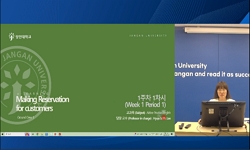Through a case study of the Gyeongseong Electric Co. (hereafter GEC) during the early 1940’s, this paper examines the particular characteristics of the labor structure and management of companies operating under wartime economic controls, as well as...
http://chineseinput.net/에서 pinyin(병음)방식으로 중국어를 변환할 수 있습니다.
변환된 중국어를 복사하여 사용하시면 됩니다.
- 中文 을 입력하시려면 zhongwen을 입력하시고 space를누르시면됩니다.
- 北京 을 입력하시려면 beijing을 입력하시고 space를 누르시면 됩니다.
부가정보
다국어 초록 (Multilingual Abstract)
Through a case study of the Gyeongseong Electric Co. (hereafter GEC) during the early 1940’s, this paper examines the particular characteristics of the labor structure and management of companies operating under wartime economic controls, as well as the lives of laborers, specifically the trolleymen at the GEC. Labor management during the late colonial period relied on an ideology of mobilization in order to control labor, but previous scholarship has portrayed the process simply as a tightening of control. To block the sudden movement of laborers, the Japanese Government-General accepted the need for a type of conciliatory policy in 1943 that permitted wage increases, provided bonuses, and offered benefits, but was intended to train “veteran laborers” [junggyeonnodongja] and more effectively control the Korean laborers. From among the trolleymen, the GEC appointed loyal, long-term employed workers as vice-supervisors or supervisors and wanted to foster these as the veteran workers. The GEC did not implement policies to rectify the mounting discontent of the Korean workers with discrimination between employee positions but used the discontent to block the workers from achieving solidarity. This policy accelerated the divisions between and the heterogenization of the Korean laborers. Junior trolleymen who had been only working for a short while were dissatisfied with the working conditions and changed companies, but the long-term workers, including the vicesupervisors and supervisors, were satisfied with the treatment of the GEC. In conclusion, the long-term consequences of the heterogenization of the Korean labor force included the post-Liberation formation of two labor unions, the Gyeongseong Electric Company Employee Union [Gyeongseongjeongi-jongeopwonjohab] and the Gyeongjeon Labor Union of the Daehan Confederation of Labor Unions [Daehannochong-Gyeongjeonnodongjohab], that fought for primacy after Liberation.
목차 (Table of Contents)
- I. 序言
- II. 인력구조의 양상과 승무원의 이동 급증
- III. 경전의 대책과 인사관리의 변화
- IV. 結語
- 참고문헌
- I. 序言
- II. 인력구조의 양상과 승무원의 이동 급증
- III. 경전의 대책과 인사관리의 변화
- IV. 結語
- 참고문헌
- ABSTRACT
참고문헌 (Reference)
1 정병욱, "해방전후 조선식산 은행원의 변화. in: 해방전후 한국의 기업과 경제변동" 2008
2 박영기, "한국노동운동사3" 지식마당 2004
3 金似郁, "한국노동운동사(상권)" 産經文化社 1974
4 김경일, "한국 노동 운동사2 : 일제 하의 노동운동1920~1945" 지식마당 2004
5 안자코유카, "총동원체제하 조선인 노동력 ‘강제동원’ 정책의 전개" 고려사학회 14 : 10-348, 2003
6 미즈노나오키, "창씨개명" 산처럼 2008
7 정운혁, "창씨개명" 학민사 1994
8 정혜경, "조선총독부의 노무동원 관련 행정조직 및 기능분석" 한국민족운동사학회 (54) : 213-270, 2008
9 허수열, "제주도에 있어서 조선인 강제 동원. in: 일제 말기 제주도의 일본군 연구" 2008
10 선재원, "전시노동력동원과 노동자생활. in: 일제 파시즘 지배정책과 민중생활" 혜안 2004
1 정병욱, "해방전후 조선식산 은행원의 변화. in: 해방전후 한국의 기업과 경제변동" 2008
2 박영기, "한국노동운동사3" 지식마당 2004
3 金似郁, "한국노동운동사(상권)" 産經文化社 1974
4 김경일, "한국 노동 운동사2 : 일제 하의 노동운동1920~1945" 지식마당 2004
5 안자코유카, "총동원체제하 조선인 노동력 ‘강제동원’ 정책의 전개" 고려사학회 14 : 10-348, 2003
6 미즈노나오키, "창씨개명" 산처럼 2008
7 정운혁, "창씨개명" 학민사 1994
8 정혜경, "조선총독부의 노무동원 관련 행정조직 및 기능분석" 한국민족운동사학회 (54) : 213-270, 2008
9 허수열, "제주도에 있어서 조선인 강제 동원. in: 일제 말기 제주도의 일본군 연구" 2008
10 선재원, "전시노동력동원과 노동자생활. in: 일제 파시즘 지배정책과 민중생활" 혜안 2004
11 金重烈, "저축장려회 기금 횡령사건 및 경전쟁의. in: 항일노동투쟁사" 集賢社 1977
12 이상의, "일제하 조선인 '중견노무자'와 노동규율" 고려사학회 (18) : 105-139, 2004
13 이상의, "일제하 조선의 노동정책 연구" 혜안 2006
14 이상의, "일제하 전시체제기의 임금통제와 조선인노동자" 한국민족운동사학회 (57) : 131-168, 2008
15 이병례, "일제하 전시체제기 노동자의 경험세계" (11) : 2002
16 이병례, "일제하 전시체제기 경성부의 노동력 동원구조" 수선사학회 (24) : 43-71, 2005
17 이병례, "일제하 경성 전차 승무원의 생활과 의식" 서울학연구소 (22) : 91-129, 2004
18 곽건홍, "일제의 노동정책과 조선노동자" 신서원 2001
19 김경일, "일제의 노동정책과 노동운동" 동양학연구소 (41) : 283-303, 2007
20 이병례, "일제말기(1937~1945) 인천지역 공업현황과 노동자 존재형태" 인천학연구원 1 (1): 195-231, 2009
21 선재원, "식민지기-해방직후 화이트칼라의 내부노동시장 : 조선식산은행의사례, 1918-53. in: 해방 전후 한국의 기업과 경제변동" 2008
22 지영임, "구술을 통해 본 일제하 제주도내 강제동원의 실태와 특징" 한국사회사학회 (72) : 73-102, 2006
23 정병욱, "경제성장론의 ‘인력개발’ 인식비판. in: 일본의 식민지 지배와 식민지적 근대" 동북아역사재단 2009
24 金鎔基, "韓國における生活保障型處遇制度の形成. in: 人事勞務管理の歷史分析" ミネルヴァ書房 2003
25 宣在源, "近代朝鮮の雇用システムと日本" 東京大學出版會 2006
26 김윤미, "總動員體制와 勤勞報國隊를 통한 ‘國民皆勞’-조선에서 시행된 근로보국대의 초기 운용을 중심으로(1938~1941)-" 한일민족문제학회 (14) : 121-162, 2008
27 "綠旗"
28 "社員住所錄" 京城電氣株式會社 1944
29 "每日新報"
30 "東亞日報"
31 "朝鮮電氣雜誌"
32 "朝鮮鐵道協會會誌"
33 "朝鮮行政"
34 "朝鮮社會敎育要覽" 朝鮮總督府學務局社會敎育課 1941
35 宮田節子, "朝鮮民衆과「皇民化」政策" 一潮閣 1997
36 "朝鮮日報"
37 "朝鮮勞務"
38 許粹烈, "朝鮮人 勞動力의 强制動員의 實態. in: 日帝의 韓國植民統治" 정음사 1985
39 宮孝一, "朝鮮の勞務者" 東都書籍 1945
40 "朝鮮"
41 "朝光"
42 安秉直, "日本窒素における朝鮮人勞動者階級の成長に關する硏究" (25) : 1988
43 최원영, "日帝末期(1937~1945)의 靑年動員政策-靑年團과 靑年訓練所를 중심으로" (21) : 1999
44 李孝秀, "日帝後記(1930~1945) 朝鮮勞動市場硏究. in: 韓國近代經濟史硏究의 成果" 螢雪出版社 1989
45 朴淳遠, "日帝下朝鮮人熟練勞動者의形成; 오노다(小野田)시멘트勝湖里공장의事例" (51) : 1994
46 "新時代"
47 林信澤, "挑戰: 電力勞組40年史" 全國電力勞動組合 1988
48 김영희, "國民總力朝鮮聯盟의 사무국 개편과 官邊團體에 대한 통제(1940.10~1945.8)" 한국근현대사학회 (37) : 233-269, 2006
49 "國民總力"
50 "勞動"
51 "京電彙報"
52 "京電"
53 岸謙, "京城電氣槪覽" 京城電氣株式會社 1944
54 佐脇精, "京城電氣槪覽" 京城電氣株式會社 1940
55 "京城電氣六十年沿革史" 京城電氣株式會社 1957
56 "京城日報"
57 "京城府勢一斑" 京城府廳
58 오진석, "1930년대 京城電氣의 인사관리와 女乘務員" 한국근현대사학회 (50) : 170-199, 2009
59 오진석, "1930년대 京城電氣의 사업부문별 경영분석을 통해 본 대중교통기구로서의 위상" 대동문화연구원 (60) : 321-360, 2007
60 곽건홍, "1930·40년대 서울지역 공장 여성노동자의 생활. in: 鄕土서울 70" 2007
61 김경일, "1925년 서울 전차 승무원의 노동 쟁의 연구. in: 일제하의 사회운동과 농촌사회" 文學과知性社 1990
62 吳鎭錫, "1910~1920년대 京城電氣의 강압적 인사관리와 노동자의 저항" 한국사연구회 (141) : 219-257, 2008
동일학술지(권/호) 다른 논문
-
- 서울시립대학교 서울학연구소
- 심재연
- 2010
- KCI등재
-
- 서울시립대학교 서울학연구소
- 문안식
- 2010
- KCI등재
-
『姓源錄』을 통해서 본 서울 중인 가계 연구 - 중인 가계의 유형과 규모 및 정체성 -
- 서울시립대학교 서울학연구소
- 김두헌
- 2010
- KCI등재
-
- 서울시립대학교 서울학연구소
- 김해경
- 2010
- KCI등재
분석정보
인용정보 인용지수 설명보기
학술지 이력
| 연월일 | 이력구분 | 이력상세 | 등재구분 |
|---|---|---|---|
| 2025 | 평가예정 | 재인증평가 신청대상 (재인증) | |
| 2022-01-01 | 평가 | 등재학술지 선정 (계속평가) |  |
| 2020-01-01 | 평가 | 등재후보학술지 선정 (신규평가) |  |
| 2019-12-01 | 평가 | 등재후보 탈락 (계속평가) | |
| 2018-12-01 | 평가 | 등재후보로 하락 (계속평가) |  |
| 2015-01-01 | 평가 | 등재학술지 유지 (등재유지) |  |
| 2011-01-01 | 평가 | 등재학술지 유지 (등재유지) |  |
| 2009-01-01 | 평가 | 등재학술지 유지 (등재유지) |  |
| 2008-10-02 | 학술지명변경 | 한글명 : 서울학연구 -> 서울학연구 |  |
| 2006-01-01 | 평가 | 등재학술지 선정 (등재후보2차) |  |
| 2005-01-01 | 평가 | 등재후보 1차 PASS (등재후보1차) |  |
| 2004-01-01 | 평가 | 등재후보 1차 FAIL () |  |
| 2003-01-01 | 평가 | 등재후보학술지 선정 (신규평가) |  |
학술지 인용정보
| 기준연도 | WOS-KCI 통합IF(2년) | KCIF(2년) | KCIF(3년) |
|---|---|---|---|
| 2016 | 0.63 | 0.63 | 0.68 |
| KCIF(4년) | KCIF(5년) | 중심성지수(3년) | 즉시성지수 |
| 0.61 | 0.62 | 1.483 | 0.14 |




 DBpia
DBpia






